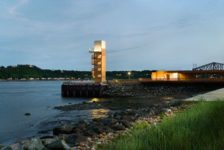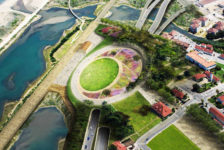Food producing landscapes are more controversial than your typical landscape project. As mentioned in a previous post, urban gardens often trigger a sense of environmental stewardship from people, but successful design is key to public acceptance. Urban agriculture is an umbrella term for the many different contexts of food production that occur outside the typical context of rural farms — food gardens for residential properties, community gardens and market scale farms to name a few — each of which has very different user needs. However, a common set of principles can help guide the design process for any of them.
Aesthetics
1) Use hardscape features to create aesthetic definition.
The clean lines of paths, patios, fences, raised beds, retaining walls, arbors, trellises and pergolas can all be used to create order out what can sometimes be a chaotic and cluttered plantscape. Fruit trees espaliered along a rigid structure (i.e. wood or wires) or a turning a hillside into a terraced vineyard are examples.
2) Maximize ornamental characteristics of edibles.
The aesthetics of edibles have much to do with how they are trained, pruned and cared for. A well-pruned fruit tree or grapevine can be truly stunning. However, some edibles have much higher aesthetic qualities than others, making them good candidates for high profile locations in the landscape. These include shrubs like blueberries and pomegranates; vines such as grapes and kiwis; trees like Asian persimmons and apricots; and vegetables such as rainbow chard, colored lettuces and eggplant.
RELATED STORY: Downtown Detroit Springs to Life with Lafayette Greens
3) Choose an appropriate aesthetic motif.
Food producing landscapes lend themselves to informal styles. They are intended to be entered and worked in, more than viewed. Thus, sleek modernist or minimalist approaches are generally not the way to go; a ‘workshop’ garden environment highlighted with natural stone and post and beam structures of rough-sawn timbers or weathered iron is a better fit.
Function
4) Treat the soil and plantscape as a living system.
Incorporate nitrogen-fixing groundcovers and hedges to help replace some of the nitrogen lost in the harvest and maximize the use of free-flowering perennials (rosemary, bee balm, lavender, yarrow, etc.) to attract and harbor the beneficial insects that help keep pest populations in check. Water features should be in the form of pond and wetlands for amphibian habitat (another form of pest control), rather than sterile fountains.
5) Integrate outdoor dining/gathering spaces.
Urban agriculture is about the cycle from food to plate, making it important to design for events and celebrations. Pizza ovens, outdoor kitchens, picnic tables and room for crowds are design elements to consider.
RELATED STORY: Why Landscape Architects Stopped Specifying Edible Plants (And Why They Have Started Again)
6) Plan for the unique functional requirements of food-producing landscapes.
Storage for tools and equipment, compost facilities, specialized irrigation systems, greenhouses, livestock quarters, processing areas and farmstands are typical components of ‘working’ landscapes that are slightly different than what typically falls under the purview of landscape architecture. They are all relatively simple to design in and of themselves, but putting them together into a cohesive, functional plan can require a lot of homework on the part of the designer.
7) Think vertically.
Urban agriculture is about maximizing food production in small spaces. From training vines on fences, walls and other support structures to layering edibles in the canopy, shrub and ground level plantings and exploring the use of greenhouse aquaponics systems, the potential to increase yield is largely up to the ingenuity of the designer.
Intangibles
8) Utilize interpretive elements to engage users.
Signage can be a very tacky design feature, but it in the case of edible landscapes it can really help the public to engage with what they are seeing. In addition, the creative use of food- and agriculture-themed symbolic elements — artwork, repurposed farm implements or stylized irrigation channels, for example — can go a long way toward creating food-producing landscapes that are rich with meaning. Urban agriculture is as much about the connection to food as it is about growing food.
9) Collaborate with specialists when needed.
Landscape architects are used to hiring sub-consultants like civil engineers and lighting designers, but a different set of specialists are in order when designing urban agriculture sites. The list in #6 above hints at some of the areas where this may come up, but there are also technical applications like aquaculture and hydroponics where the assistance of a specialist will almost certainly be in order.
10) Mitigate liabilities with barriers, signage and management strategies.
Safety in regards to things like bee hives and farm implements is crucial on urban farms, which may need to be secured after hours for these reasons. There is also liability in inviting people to eat what is planted and landscape architects have to work with their clients to create physical interventions or other means to prevent unintended negative consequences.
Images via Ken Weikal
Part three of a six-part series on urban agriculture
Want even more urban agriculture content? Check out our new Urban Agriculture Pinterest Board!
Published in Blog












